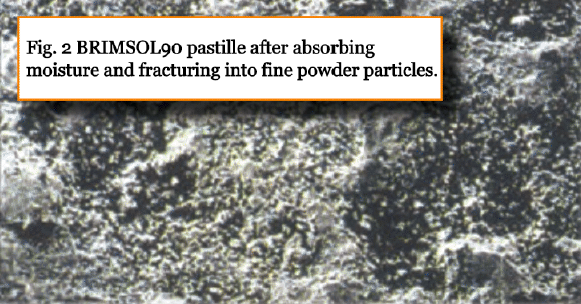
Jun 3, 2021
Navigating sulphur products
Is there a difference between elemental sulphur and sulphur bentonite?
Yes, there are significant differences, although very, often the terms elemental sulphur and sulphur bentonite are used interchangeably. While both products are valuable, they each have very specific uses. Elemental sulphur is mined or recovered from fossil fuel production. Greater than 50% of all global sulphuric acid production results from the burning of elemental sulphur. Sulphuric acid is extremely important to the fertilizer industry, which uses it to manufacture phosphates, and to a lesser extent nitrogen, potassium, and sulphate fertilizers.
Elemental sulphur
Elemental sulphur is utilized in several other industries including non-ferrous metals, pigments, fibers, pharmaceuticals, agricultural pesticides, personal care products, cosmetics, synthetic rubber vulcanization and water treatment. The characteristics of elemental sulphur are: non-metallic chemical element, a yellow crystalline solid, insoluble in water, odorless and 99.5% pure.
The “bentonite” in sulphur bentonite
Generally, the term bentonite is used for any plastic, colloidal, swelling day regardless of its geological origin. Bentonite clays are predominately composed of minerals from the montmorillonite group, which exhibit a significant amount of plasticity, cohesion, swelling, and shrinkage. It is these bentonite characteristics that are so important because they enhance the reaction of sulphur.
Sulphur: an essential plant nutrient
Sulphur, along with NM, is an essential plant nutrient. It contributes to crop yield increases via:
- direct plant nutrient value,
- indirect plant value as a soil amendment, especially for calcareous & saline/alkali soils; and
- the increased efficiency of other essential plant nutrients.
The question is: if sulphur is so important for plant growth, how can it benefit plants when it is a solid and insoluble in water?
The answer is that sulphur must undergo microbial breakdown in soil prior to uptake by plants. This microbial process is sulphur oxidation, which converts elemental sulphur to plant available sulphate (SO4-sulphur. Sulphur oxidation is a function of several factors including soil temperature, soil moisture, population of microorganisms (Thiobacillus), and sulphur particle Axe. Optimum conditions for greatest sulphur oxidation rates include soil temperatures between 75 and 100 degrees F and soil moisture slightly less than field capacity.
The importance of thlobacillus
Bacteria Sulphur oxidation also increases as the population of Thiobaeillus bacteria increases. Thiobacillus bacteria population rises with repeated applications of sulphur. When sulphur is applied as part of a planned nutrient application program and applied annually or semi-annually, it provides ample food supply for the Thiobacillus bacteria. Therefore, the Thiobacillus bacteria become more active and reproduce as food supply supports the population. Greater bacteria population results in faster oxidation of S to S04.
Sulphur Particle Site
Sulphur particle size can be influenced and hence the addition of bentonite clay to elemental sulphur. Bentonite clay upon exposure to water has the capacity to swell up to Is times its dry volume. Sulphur bentonite contains 10-15% clay (Fig. 1). When field applied, the clay in the sulphur pastilles absorb soil moisture and swells resulting in the sulphur pastilles fracturing into very small particles (Fig. 2). These particle sizes can range from goo to 6o microns. Smaller sulphur particles provide greater surface area for Thiobacillus bacteria to feed on the sulphur and oxidize it to sulphate. There is an inverse relationship between particle size and surface area. The oxidation rate increases exponentially as sulphur particle size decreases.
Pure sulphur
Pure elemental sulphur (09.5%) is oftentimes referred to as ‘soil sulphur”. It has significantly larger particle sizes and a much slower oxidation rate as compared to sulphur with bentonite clay. It is the larger particle sizes in elemental sulphur that require months to a year or longer for the oxidation process to occur (Fig. 3). Elemental sulphur is sometimes utilized as a nutrient source/soil amendment. Soil amendment is the addition of a product to soil to alter its physical, chemical, and/or biological characteristics to enhance plant growth. When soil pH is above the optimum range, elemental sulphur can be added in much higher quantities than needed for plant nutrients to create acidity in soil and lower the soil pH. Of course, BRIMSOL90 sulphur can be applied as a soil amendment and provide faster reaction.
Drop form technology
BRIMSOL90 Products has invested a significant amount of time, effort, and resources into adapting and refining the ‘drop form technology’ to produce a superior bentonite sulphur product. It is with the addition of bentonite clay to the sulphur matrix that enhances the functionality of the sulphur. This results in faster S to SO4 conversion, greater availability of SO4 for plant uptake, increased plant growth response, and ultimately higher crop yields.
References
- The sulfur Institute (TSI) Washington, D.C. www.sulphurinstitute.org
- Tisdale, Nelson, & Beaton, 1985. Soil Fertility & Fertilizers. 4th
- Wyoming Mining Association, Cheyenne, WY









